Nymphs
{{start}}
The word nymph has of course two fly fishing meanings. The first is “Juvenile, sexually immature stage of certain insects, usually similar to the adult in form, and which require an intermediate stage before becoming an adult. Mayflies, Caddis flies, Dragonflies, Damselflies, Stone flies and Midges are all insects that spend part of their life cycle in the water and have a nymph stage.” The second which is flies tied to the first i.e. “the nymphal stage of an insects life cycle.I have narrowed down the selection of nymphs that I carry to the list below’.
{{end}}
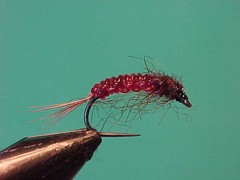
{{+1}}Flat knitted nymph{{-1}}
{{start}}
Because the nymphs of many mayflies and caddis spend a good part of their life cycle living under rocks in both still and running water its not surprising that many have taken on a relatively flat form. This knitted grub has a relatively flat body mimicking many of the naturals and also has plenty of structure on the body suggesting the various body segments.{{end}}
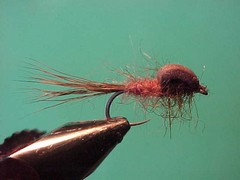
{{+1}}Floating nymph{{-1}}
{{start}}
This nymph applies elements of each of these two principals of science. The materials are all as buoyant as possible. This includes the tail which is deer hair and of course "hollow' and the closed cell foam which has tiny bubbles of air trapped within its membrane. It also has a reasonable "foot print" made up of the tail, and teased out seals fur body and thorax. Seals further adds a further benefit to the fly in that with a couple of brisk false casts it easily sheds water.{{end}}
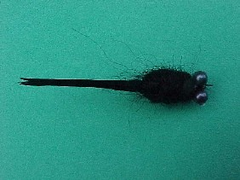
{{+1}}Tadpole{{-1}}
{{start}}
Fish the tadpole fly either on the drop or the lift in shallow water around detritus matter. This action mimics the action of a tadpole coming to the surface to breath and then returning to its cover and is a prime time for trout to strike.{{end}}
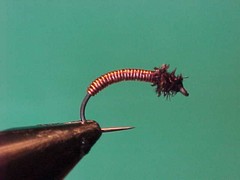
{{+1}}Brassie{{-1}}
{{start}}
The Brassie fly has been around for a long time and certainly has a place in ever river fly box. It's a handy fly to have on hand if you need a buggy looking fly that sinks quickly or an anchor fly for a team of two or three flies.{{end}}
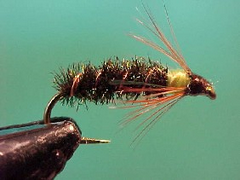
{{+1}}Stick fly{{-1}}
{{start}}
There are more versions of stick flies than you can poke a stick at (excuse the pun) and this one is a compilation of a couple that I like. Its easy to tie and works well particularly early in the season when the water is just starting to warm up and there isn't that much food about.{{end}}
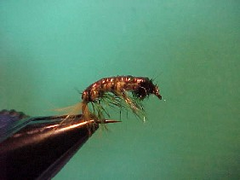
{{+1}}Scud{{-1}}
{{start}}
I use this fly to represent not only Scuds but also Olive Caddis Pupa which are of course a completely different types of creature. Scuds are true crustaceans of the family Isopod or Amphipods and generally you find them in shallow water in the detritus matter and around weed beds and drowned vegetation.{{end}}
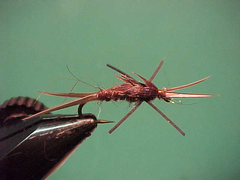
{{+1}}Stone fly{{-1}}
{{start}}
Stoneflies thrive in the rubble of cold well oxygenated rivers & streams. They are an available food source throughout the season and fish may feed on them to the exclusion of all other food sources particularly during hatches. The nymphs crawl along the bottom and exit the water at the stream or river edge where they hatch into stoneflies.{{end}}
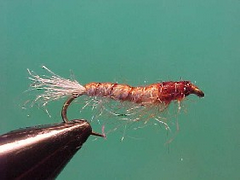
{{+1}}Free swimming caddis{{-1}}
{{start}}
The third group are the free swimming caddis grubs. These caddis grubs move amongst the detritus matter and the rocks foraging for food and partners and of course drift in the current assuming the fetal position or free swim in the current as they migrate down stream.{{end}}

{{+1}}Czech nymphs{{-1}}
{{start}}
The uncased caddis have quite a few similarities. They often adopt a curved fetal position and when they are free swimming they are more elongated still with a curved back but with a lifted head. The have short tail like filaments, have bodies of around seven or eight segments that may have abdominal gills at each segment, have darker heads with two or three segments and have 3 or more sets of legs below the head or toward the front of the grub.{{end}}

{{+1}}Woolly worm{{-1}}
{{start}}
This is an old pattern and whilst it can be dressed in many different ways I prefer it dressed as described below which is similar to the original form with the exception of the tail which I prefer to be much finer than the original. I guess that makes it like a small Woolly Bugger. This fly works well in streams when fished across and down and is also a useful fly when fish are in still water mooching amongst flotsam & jetsam.{{end}}













